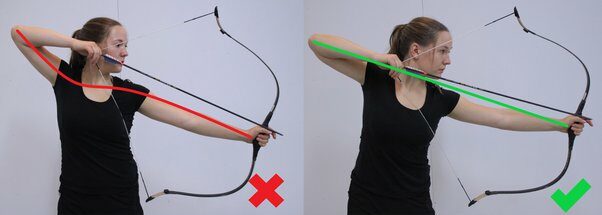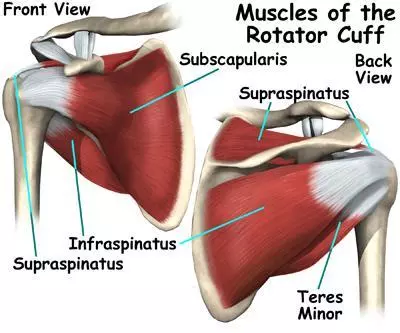If you choose to shoot arrows in your backyard, the chances are that at some point, you’ve placed your targets low to the ground. This method of backyard target shooting might be much safer for your neighbours, but if you’re not doing it correctly, you might start to feel a nagging pain in your shoulder. That could lead to the most common backyard archery injury.
There are many ways in which poor archery techniques can lead to long-term injury. Shooting at low targets with poor form can potentially give you one of the most problematic.
When you aim down at something low to the ground, there is a tendency with new archers to lower the bow hand to point the arrow towards the target. But this movement puts the shoulders in a compromised position. It re-directs the forces travelling up the arm, and in turn, could lead to long-term pain and inflammation in the shoulder joint. To correctly disperse those forces, we need to keep the bow hand still and pivot forward from the waist to keep the shoulders in line.
In this article, we’ll look at which muscles are involved in the shoulder during archery. We’ll learn how to bulletproof those muscles to avoid inflammation, along with a couple of pointers when it comes to technique.
What Is The Most Common Backyard Archery Injury?
When we set our targets low to the ground it’s easy to think that all we have to do is adjust our aim accordingly by dropping the leading bow hand.
But what that does is change the position of the front shoulder by dropping it below the right elbow. So in effect, we end up pivoting at the anchor point instead of at the waist.

What we have to remember here is that the forces generated by the bow are travelling back up the arm and into the shoulder. This places the rotator cuff muscles of the shoulder under a lot of strain.
But if we are perfectly aligned, then those forces are distributed evenly across the shoulders and the upper-back muscles.
When the bow hand is dropped, the shoulder girdle becomes misaligned and the forces are directed straight up and into the rotator cuff muscles. Over time, this technique error can cause chronic inflammation and lead to rotator cuff tendinitis which is the most common backyard archery injury.
This article will give you all the info on the best DIY targets for your backyard archery range!
How To Avoid Common Backyard Archery Injury While Shooting at Low Targets?
Fix Your Technique
The fix is a very simple one. Instead of dropping the bow hand to aim at the target, you simply keep your shoulders level and tilt forward from the waist.
This positioning of the body doesn’t break the line across your shoulders. Your back and shoulder muscles will engage and take the tension in the correct way, and the force of the bow is dissipated away from the front shoulder.
We need to keep our front shoulder down and low and lean forward from the hips. This is especially good for shooting 3D archery where the targets are particularly low to the ground.
If you’re a right-handed archer, try to think of your right elbow, both shoulders and your bow hand as three fixed points when in the fully drawn position.
As you aim low to the ground those fixed points need to remain in a straight line when you lean forward at the waist.
Warm Up Correctly
The biggest mistake people make when they warm up before they exercise, is that they static stretch the muscles rather than mobilize them.
Static stretching is great, but it should come after you’ve exercised, not before.
Instead, start by holding your arms out to either side at shoulder height. Then start making small circles, and gently increase the size as you get warmer. 10 circles in each direction are enough.
If you have a light resistance band you could anchor one end and perform external rotations while holding the other end of the band. While facing the anchor point, keep your arm bent at 90 degrees with your upper arm parallel to the floor.
Rotate your shoulder so that your forearm raises up. Do 10 on each arm before turning to the side, drop your arm tight into your side and rotate out from the shoulder.
No need to go too heavy for rotator cuff exercises as the main purpose is to get the blood flowing into the tendons so that they are nice and warm before you start shooting.
Don’t Shoot To Exhaustion
When you’re shooting at home in the backyard, it’s so easy to think that you have all the time in the world. You have the place to yourself, you’re not waiting for anyone to finish shooting, you have plenty of arrows and your phone’s on silent!
Just remember that shooting low targets for long periods of time can increase the chance of your shoulders fatiguing and injury setting in. Take plenty of breaks if you’re planning on shooting for more than an hour at a time.
What Are The Rotator Cuff Muscles?
The rotator cuff muscles are a group of four muscles that sit around the shoulder joint. Their role is to stabilize and support the shoulder capsule throughout a variety of movements. An easy way to remember them is by using the acronym SITS.
- Supraspinatus
- Infraspinatus
- Teres Minor
- Subscapularis

Rotator cuff injuries are among the most common injuries in any sport involving stabilization at the shoulder joint.
The rotator cuff muscles all originate at the shoulder blade, but the tendons all insert into different parts of the upper arm.
This is why archers are often complaining of sore shoulders the day after shooting at low targets all afternoon.
If you need to brush up on your backyard archery safety, then this article is for you.
Conclusion
Whether by default or by choice, shooting arrows in your very own backyard archery range can be a fun and rewarding experience.
You just need to remember that shooting low targets may be a safer backyard option, but it poses the risk of chronic injury if you let your technique slip.
With just a few tweaks to your form can avoid the most common backyard archery injury and continue with that all-important progress!

0 Comments